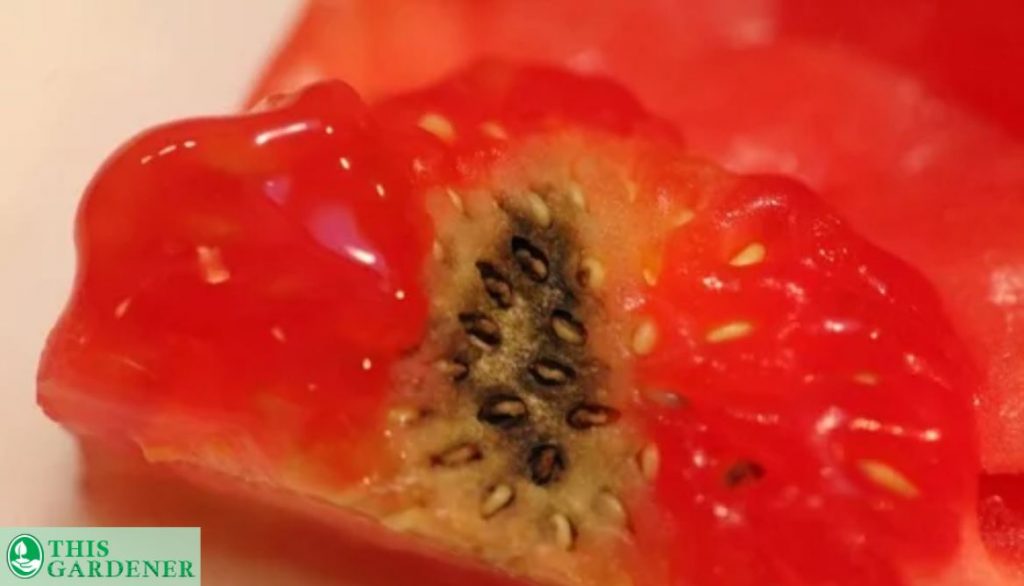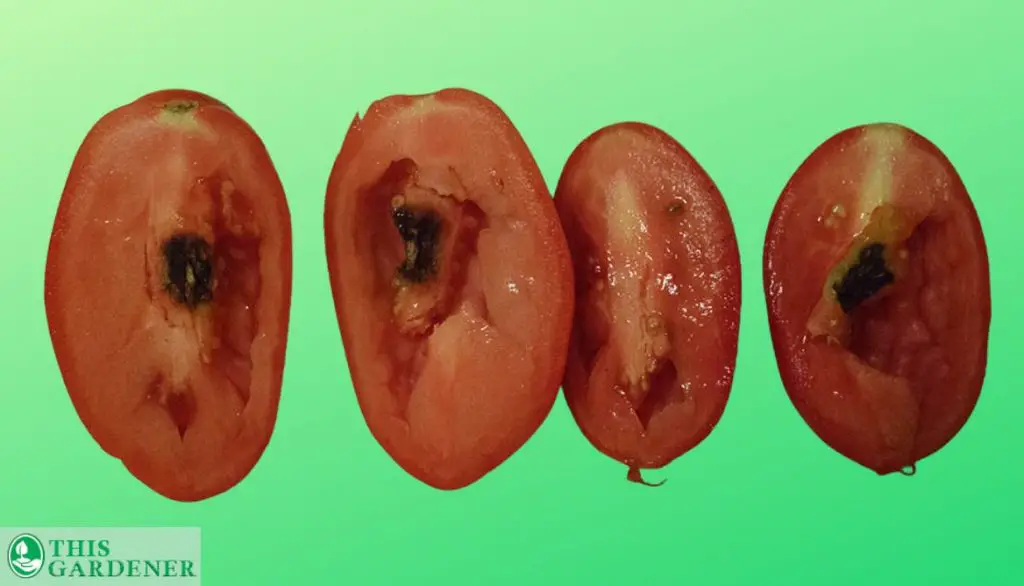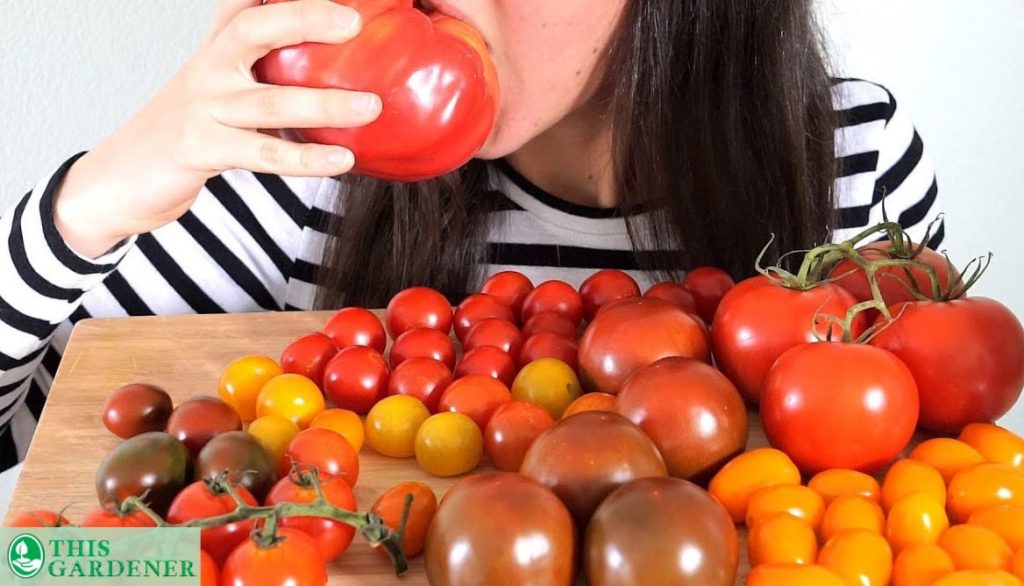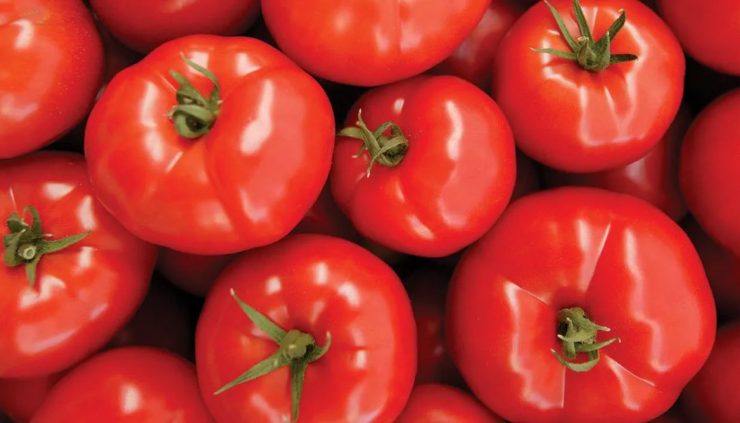Tomato is a mandatory ingredient in most cuisines around the world. And of the key attractions in most salads. But, did you know that tomato seeds can turn out to be black seeds inside tomato in some cases?
The tomato and seeds both can turn black due to many reasons. Fungi, bacterial diseases, B.E.R (Blossom End Rot), or even improper care of the tomato can be the reason
How does one solve this problem? Dark seeds are a common sight even in fresh tomatoes and there is nothing to be afraid of the dark colored seeds. In fact, you can consume them. Learn more about the black spots and seeds on the tomato by discussing black seeds and spots inside the tomato in detail!
Contents
Why Are My Tomato Seeds Black?

Tomatoes that grow into healthy fruits will have seeds that have greenish-yellow colored seeds. But at times you might notice that the color of the seeds is now what you don’t expect. They may seem brownish, dark greenish with a pale yellow tint, or black.
There are multiple factors that contribute to this scenario. Some of these are related to the care of the tomatoes while others may be due to negligence. Either way, let’s look into these reasons in detail. Let’s get started!
Over-ripened Tomatoes
An overripe tomato can also have black seeds which are very common. In overripe tomatoes, the seeds may be close to germinating and sprouting. This is the reason for such an odd coloration.
Blossom End Rot
Blossom end rot is a disease that causes dark seeds or black spots on the tomato. It is not safe to consume a tomato with such a condition.
Tomatoes Picked Too Early
If the tomato is picked earlier than the ideal time then it is most likely that the tomato seeds may undergo irregular change. A detached tomato has low levels of abscisic acid which is an essential part of growth.
The tomato seeds will as a result turn into black seeds. These dark seeds though according to many are safe to consume.
Other Causes for Dark Seeds
There are numerous other reasons for black seeds found in tomatoes. they are:
Exposure to extreme cold
Lack of watering
Lack of fertilization
Low calcium
pH imbalance
What Causes Blossom End Rot?

The main culprit that causes B.E.R is the deficiency of calcium. Tomato plants require a high amount of calcium to grow healthy tomato fruit.
Can Overwatering Cause?
Yes. Overwatering causes the roots to be submerged in the water. The roots then rot and this results in little to almost no nutrients for the tomato. Hence, causing the black coloration.
How Can We Prevent Blossom End Rot in Tomato Fruit?
Prevention of the problem will help you to secure your harvest of tomatoes and ensure that further same issue is not identified. Maintaining a healthy growth environment is one of the best cures. Let’s check out some useful ways to prevent B.E.R from occurring!
Exposing the tomatoes to at least six to eight hours of sunlight greatly helps! But try to avoid intense exposure.
Main a high amount of nitrogen during the vegetative phase and reduce it during the fruit ripening phase.
Ensuring the optimum ratio of nutrients in the soil is a crucial method. A 10-10-10 NPK ratio during the growth phase and a 5-10-10 NPK ratio during the fruit developing phase.
Keeping the soil according to the need of the tomatoes is one more important step. Tomatoes require well-drained soil that has a light loamy texture.
Maintaining the pH level of the soil from slightly acidic (6.0) to neutral (7.0) is ideal for the plant.
Follow a 1-inch watering regime during the growth phase of the tomatoes.
Temperature balance plays a key role in a healthy plant. A temperature range of 18.3-32.2ºC during its complete growing season is best. While a 21-25ºC temperature range is ideal for the best tomato yield.
What To Do if Your Tomato Plant Develops
There are numerous ways to get rid of this issue. Let’s go through some of these ways:
Removing all the affected fruits and saving the healthy ones is one way. This also helps you keep any chances of mold away.
Try to water the plants deeply so that the roots can absorb water quickly and the soil remains moist.
Mixing powered milk is one DIY trick to boost that calcium quantity in the soil.
Modify your watering routine to regularly for at least 2 weeks and you will notice healthy fruit.
Mixing coffee grounds and egg shells can also aid in balancing the calcium proportions of the soil.
Another way is to apply calcium nitrate powder directly to the tomatoes so that it absorbs them directly from the skin.
Is It Safe To Eat the Black Seeds Inside Tomatoes?

If there is no noticeable disease, rot, weird coloration, odor, or mold on the tomatoes then the tomato seeds inside are safe to be eaten. Even if you find sprouting black seeds inside tomatoes!
Can You Still Eat Overripe Tomatoes?
Yes, you can eat an overripe tomato. For some, the taste and the texture of the tomatoes can be a little off. But for some people, they are very pleasing.
Is It Safe To Eat Tomatoes With Signs of Vivipary?
Looking at a tomato with vivipary can be a little unsightly for people but it is safe to eat. But it is still advisable to consume healthy tomatoes as it has been reported by many people that such fruit can be toxic for a selected few people.
FAQ
Can you eat a tomato with a black bottom?
As long as you cut off the bottom of the tomato and eat healthy portions then it is safe to eat.
Can you eat tomatoes with black mold?
Absolutely not! Avoid eating such fruit. The mold tastes very bad and can cause major health issues if consumed.
Why are my cherry tomatoes black inside?
Fungal diseases such as anthracnose or rot can cause cherry tomato seeds to turn into dark seeds. Also, the cherry tomato fruit may have an imbalance in the plant hormone which can further cause problems.
Why are my tomatoes black inside?
The fungi that wreak havoc during warm temperatures cause the spots on the tomato. The tomato can get attacked by a condition known as anthracnose which causes black coloration.
Is it OK to eat tomatoes with black spots?
If you notice back spots on the tomatoes then make sure to check for other signs if the fruit is bad or not. Otherwise, cut off the affected areas of the tomato and consume the fresh part.
Why is there black inside my tomatoes?
There are numerous reasons for the tomatoes to be black inside. Some causes are:
– Overripening
– Blossom end rot
– Bacterial diseases (e.g. bacterial canker, bacterial spot, bacterial speck)
– Early blight fungus
Conclusion
The short answer to the problem of black seeds is that you need to take care of the ideal conditions to grow the tomatoes. Taking care of potassium deficiency and calcium requirements to avoid any dark spots is one way.
Eating tomatoes with black seeds may not cause life-threatening issues but most people are allergic to them. You should prefer fresh fruit and throw spoiled ones. You may also slice the tomato fruits to check if any smell or visible signs of spots are present on the tomatoes.
Let us know how our guide helped you avoid the B.E.R. Or how well it informed you about the possible dangers of the rot to your health.
Either way, we hope to hear from you. Leave your comments and feedback in the comments section! We will be overjoyed with your response!
References
https://www.thespruce.com/tomatoes-turning-black-on-the-bottoms-848186
https://backyardblossomguides.com/can-overwatering-cause-blossom-end-rot-in-tomatoes/
https://thegrowingleaf.com/tomatoes-turning-black-7-common-causes-and-fixes/
- How to Get Potatoes to Sprout Eyes: Detailed Growing Guide with 3 Options - July 31, 2023
- Weight of a Medium Potato: Revealed in Detailed Guide - July 29, 2023
- Maris Piper Potatoes: 9 Substitutes You Should Know About - July 27, 2023
Hello! I’m Jessica Zander, a garden coach and consultant based in the Boston area (zone 6b), offering virtual consultations across the country and Canada.
I’ve been passionate about gardening since the early 1990s, and in 2022, I launched You Can Do It Gardening to empower individuals to feel more confident in their gardening endeavors.
Following a 30-year career in nonprofit finance and operations, I transitioned out of that field in mid-June of 2023 due to the growing demand for coaching services. Interestingly, my years of presenting financial statements to boards and finance committees proved to be valuable experience for teaching people about gardening! I enjoy sharing skills, providing guidance and suggestions, and collaborating efficiently with clients to make significant improvements to their outdoor spaces, both small and large. I also regularly teach at the Arlington Continuing Education and Cambridge Adult Education.
My approach is direct and practical, akin to Mary Poppins, but tailored to your garden. Clients find satisfaction in saving money and taking pride in their own gardening achievements.


Add comment